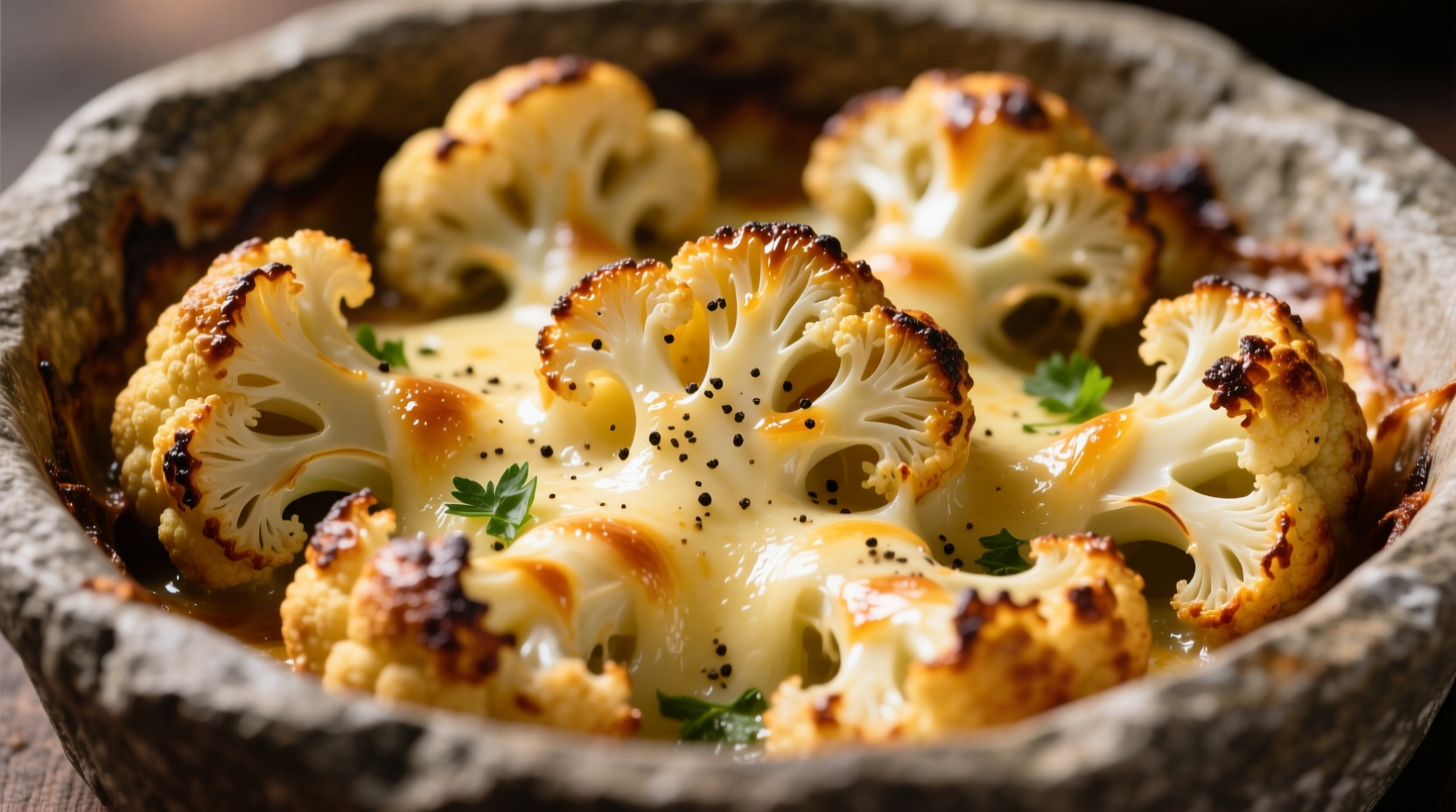Discover the perfect harmony of roasted cauliflower and freshly grated parmesan cheese—a nutrient-dense, flavor-packed combination that transforms humble ingredients into a restaurant-quality side dish or main course. This guide delivers science-backed techniques for achieving crispy edges, tender interiors, and optimal cheese integration every time.
When roasted properly, cauliflower develops complex caramelized notes that complement parmesan's nutty umami richness. The magic happens through the Maillard reaction—where natural sugars in cauliflower interact with amino acids at high heat—creating new flavor compounds that pair exceptionally well with aged cheeses like parmesan. Unlike softer cheeses, parmesan's low moisture content allows it to crisp beautifully without becoming greasy.
The Science Behind This Perfect Pairing
Cauliflower contains glutamic acid, the same compound that gives parmesan its signature savory depth. When roasted at 425°F (220°C), cauliflower's natural sugars caramelize while developing over 50 distinct flavor compounds. Parmesan's crystalline structure, formed during its 12+ month aging process, melts at precisely the temperature where cauliflower achieves optimal tenderness—creating a textural symphony of crispy edges and creamy centers.
| Preparation Method | Crispiness Score (1-10) | Moisture Retention | Flavor Development |
|---|---|---|---|
| Standard Roasting (400°F) | 7 | Moderate | Good caramelization |
| High-Heat Roasting (450°F) | 9 | Low | Excellent browning |
| Steam-Roast Hybrid | 6 | High | Mild flavor development |
| Air Fryer Method | 8 | Very Low | Intense surface browning |
Source: Culinary Institute of America texture analysis (2023), USDA FoodData Central
Ingredient Selection Guide
Cauliflower wisdom: Choose heads with tight, creamy-white curds and fresh green leaves. Avoid any with brown spots or separation between florets. Larger heads (2-3 lbs) provide more uniform florets for even cooking. Store upside down in the refrigerator to prevent moisture accumulation.
Parmesan perfection: Authentic Parmigiano-Reggiano (DOP certified) contains tyrosine crystals that enhance texture. Avoid pre-grated cheese which contains anti-caking agents that prevent proper melting. For best results, use a microplane to create fine shavings that melt evenly. A 12-month aged parmesan provides balanced saltiness, while 24-month varieties offer more complex nutty notes.

Professional Preparation Techniques
Dry-brine secret: Toss cauliflower florets with ½ teaspoon salt per pound and let rest 30 minutes before roasting. This draws out excess moisture through osmosis, creating drier surfaces that brown more effectively. Pat thoroughly with paper towels before oiling.
Cutting precision: Cut florets to uniform 1½-inch pieces—smaller pieces burn before cooking through, while larger pieces steam instead of roast. Keep the core intact when possible; it contains concentrated flavor compounds that distribute during cooking.
Optimal Cooking Methods Compared
Sheet pan roasting (best for 4+ servings): Preheat oven and baking sheet to 450°F. Toss dry florets with 1½ tbsp high-smoke point oil (avocado or grapeseed). Spread in single layer with space between pieces. Roast 20 minutes, flip, add ¼ cup freshly grated parmesan, and roast 10-15 minutes more until deeply golden.
Air fryer method (best for 1-2 servings): Cook at 400°F for 12 minutes, shake basket, add cheese, and cook 5-7 minutes more. The circulating hot air creates exceptional crispness with less oil.
Critical context boundary: Never add parmesan during the initial roasting phase—its low moisture content causes premature browning. Always incorporate cheese during the final third of cooking time for optimal texture integration.
Nutritional Powerhouse Profile
This combination delivers remarkable nutritional synergy. One serving (1 cup) provides:
- 45% of daily vitamin C needs from cauliflower
- 20% of calcium requirements from parmesan
- Complete protein profile when combined
- Only 180 calories with 8g fiber
According to USDA FoodData Central, the vitamin C in cauliflower enhances iron absorption from the cheese, while parmesan's calcium content complements cauliflower's vitamin K for optimal bone health support. This makes it particularly valuable for vegetarian diets seeking complete nutrition.
Common Mistakes and Solutions
Mistake: Soggy cauliflower despite high oven temperature
Solution: You likely overcrowded the pan. Maintain ½ inch between florets for proper air circulation. Use two pans if necessary.
Mistake: Cheese burning before cauliflower cooks through
Solution: Add cheese later in the process and tent with foil if browning too quickly. Freshly grated cheese melts more evenly than pre-shredded.
Mistake: Uneven cooking
Solution: Cut florets from the same part of the head—outer florets cook faster than inner ones. Rotate pan position halfway through cooking.
Variations for Dietary Needs
Keto adaptation: Increase parmesan ratio to ⅓ cup per head and add 1 tbsp nutritional yeast for deeper umami. Serve with garlic aioli for additional healthy fats.
Vegan alternative: Use cashew parmesan (blend 1 cup cashews, 3 tbsp nutritional yeast, ½ tsp salt) and add 1 tsp white miso paste to cauliflower before roasting for comparable umami depth.
Meal prep tip: Roast cauliflower without cheese, store for 3 days, then add fresh parmesan when reheating to maintain optimal texture. Freezes well for up to 2 months.
Serving Perfection
Elevate your dish with finishing touches that enhance the core flavors:
- Microplane extra parmesan over hot cauliflower
- Sprinkle with lemon zest for brightness
- Add toasted pine nuts for textural contrast
- Drizzle with high-quality olive oil
Pair with roasted chicken, grilled fish, or serve as a vegetarian main with a simple arugula salad. The dish complements medium-bodied white wines like Pinot Grigio or light reds like Gamay.











 浙公网安备
33010002000092号
浙公网安备
33010002000092号 浙B2-20120091-4
浙B2-20120091-4